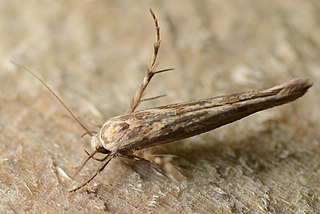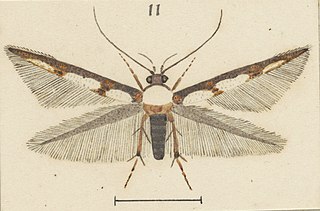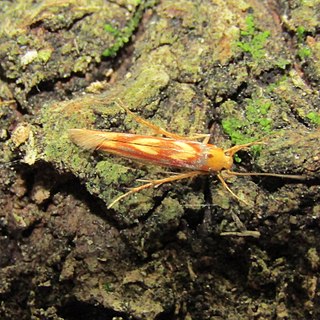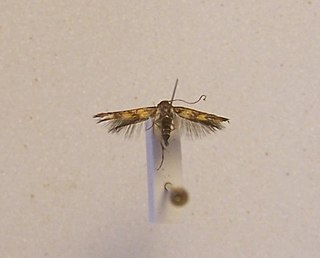Related Research Articles

Trigonospila brevifacies is a species of true fly in the family Tachinidae native to eastern Australia. This species is also found in New Zealand. Like the vast majority of tachinid flies, T. brevifacies is a parasitoid of other insects, specifically late larval stages of a number of species of Lepidoptera. It is also known as the Australian Leaf-Roller Fly or Leafroller Fly.

Stathmopoda is a genus of moths of the subfamily Stathmopodinae in the family Oecophoridae. Note that the phylogeny and systematics of gelechoid moths are still not fully resolved.

Stathmopoda campylocha is a species of moth in the family Stathmopodidae. It is endemic to New Zealand. It is classified as critically endangered by the Department of Conservation.

Stathmopoda coracodes is a moth of the family Stathmopodidae. It was described by Edward Meyrick in 1923. It is found in New Zealand.
Stathmopoda endotherma is a species of moth in the family Stathmopodidae. It is endemic to New Zealand. It is classified as "At Risk, Naturally Uncommon" by the Department of Conservation.

Stathmopoda holochra is a moth of the family Stathmopodidae. It was described by Edward Meyrick in 1889 using specimens first collected at the Wellington Botanic Garden. It is endemic to New Zealand. The larvae of this species feed on Phormium seed heads.

Stathmopoda skelloni, the yellow featherfoot, is a species of moth in the Stathmopodidae family. It is endemic to New Zealand.

Stathmopoda plumbiflua is a moth of the family Stathmopodidae. It was described by Edward Meyrick in 1911 and is found in New Zealand.

Stathmopoda mysteriastis is a moth of the family Stathmopodidae. It was described by Edward Meyrick in 1901. It is found in New Zealand.

Stathmopodidae is a family of moths in the moth superfamily Gelechioidea described by Edward Meyrick in 1913.

Stathmopoda aristodoxa is a species of moth in the family Stathmopodidae. It is endemic to New Zealand. It is classified as "At Risk, Naturally Uncommon" by the Department of Conservation.
Stathmopoda diplaspis is a moth of the Stathmopodidae family. It is found in United Kingdom, Saudi Arabia, Iran, Afghanistan, Pakistan, India, Sri Lanka, Tajikistan, Afghanistan and Thailand.
Stathmopoda masinissa, the persimmon fruit moth, is a moth of the family Stathmopodidae. The species was first described by Edward Meyrick in 1906. It is a serious pest on several persimmon species. It is found in several Old World countries Japan, Korea, Australia, Sri Lanka, Thailand and China.

Stathmopoda stimulata is a moth of the family Stathmopodidae first described by Edward Meyrick in 1913. It is found in India and Sri Lanka. Japan and Korea

Stathmopoda caminora is a species of moth in the family Stathmopodidae. It was first described by Edward Meyrick in 1890 and is endemic to New Zealand.

Stathmopoda distincta is a moth of the family Stathmopodidae. It was described by Edward Meyrick in 1926. It is endemic to New Zealand.
References
| Wikimedia Commons has media related to Stathmopoda cephalaea . |
- 1 2 "Stathmopoda cephalaea Meyrick, 1897". www.nzor.org.nz. Retrieved 2022-05-08.
- ↑ Robert J. B. Hoare (December 2001). "Adventive species of Lepidoptera recorded for the first time in New Zealand since 1988". New Zealand Entomologist. 24 (1): 23–47. doi:10.1080/00779962.2001.9722079. ISSN 0077-9962. Wikidata Q54578054.